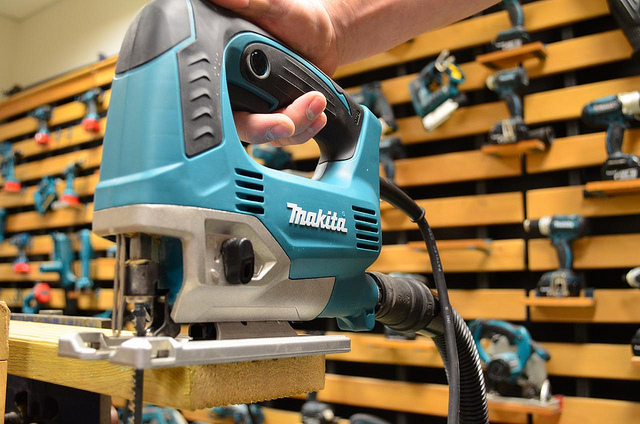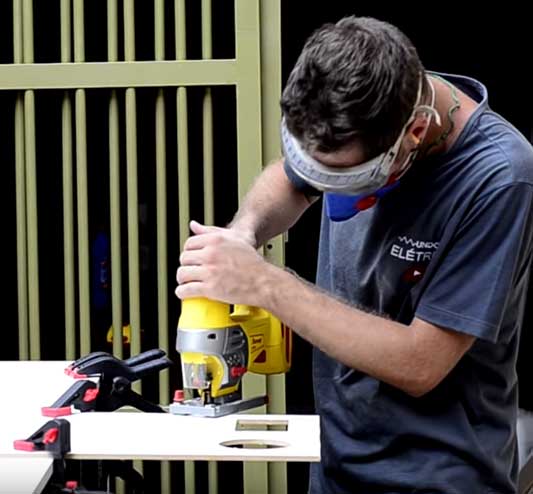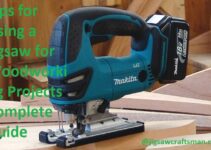Are you looking for an easy-to-follow guide on how to properly use and maintain a jigsaw? Don’t worry – we have you covered!
In this article, you’ll learn all the essential tips and tricks to safely handle a jigsaw and keep it in perfect condition. So let’s get started!
Welcome to the complete guide to safely operating and maintaining a jigsaw. In this guide, we provide a detailed overview of how to use a jigsaw, precautions you should take for safe operation, and tips for maintenance. Jigsaws are power tools used to make straight or curved cuts in wood, plastics and even light metals. They can also provide intricate decorative patterns in hard materials like ceramic tiles with the right blade and the correct technique.
We’ll first discuss general safety considerations when using any power tool, before moving on to specifics pertaining to the jigsaw. After you understand what you need to know before using a jigsaw, we’ll provide step-by-step instructions on how to set it up correctly and make cuts with it quickly and accurately. To finish off our guide, we’ll cover cleaning and maintenance tips on caring for your jigsaw over time so that it remains in good condition. Let’s get started!
Explanation of what a jigsaw is
A jigsaw is a handheld power saw with a long, curved blade that adds up-and-down movements in order to navigate through various materials. This makes them ideal for many types of projects, from intricate curves and circles to fast, straight cuts. They are also typically lightweight and easy to use, making them popular with both professional and novice craftspeople alike.
Though jigsaws have many uses, they must be operated safely in order to prevent injury or damage. This guide will cover the basics of using a jigsaw, as well as provide some tips on how to maintain it for the best performance.

Safety Precautions
When working with a jigsaw, it is important to understand and practice certain safety precautions in order to ensure your safety at all times. Consider the following important tips:
- Always use personal protective equipment such as safety goggles, gloves, aprons and steel-toe shoes when operating the jigsaw.
- Start and stop the blade slowly to help avoid kickback. If a blade binds, shut off the power immediately.
- Keep your hands away from the cutting area at all times while in operation.
- Unplug the saw when adjusting blades or making repairs and replace broken blades immediately.
- Do not force the tool’s handle into position; allow it to move freely with your hand during operation for better control.
- Never attempt to cut curves or angles with a straight blade – use only blades designed for that purpose.
- Wear hearing protection if you are working in an area with loud noise levels as prolonged exposure could cause permanent hearing damage.
Overview of safety measures
Before using a jigsaw, it is important to understand the risks associated with this type of power tool. They are designed for cutting a variety of materials, from wood and plastic to metal and ceramics. When not used correctly or used improperly, these tools can cause serious injury. To reduce the risk of injury when using a jigsaw, it is essential to follow proper safety procedures. This guide outlines key safety tips that should be followed when operating and maintaining a jigsaw.
Safety begins before even turning on the machine – one should always inspect the saw itself for any visible damage, check all cords and cables for fraying or wear and tear, ensure the blade guard is properly attached, familiarize oneself with any relevant controls on the saw (speed settings etc.) and make sure to use hearing protection during use. When handling the saw always keep a firm grip on it at all times during operation as any sudden movement could lead to an accident; if working on ladders or other high surfaces, ensure they are stable and secure at all times while in use; also consider wearing protective clothing such as heavy work gloves and eye protection that covers both the eyes and face from flying sawdust particles.
Furthermore, when cutting long pieces of material be sure to support them securely from below so as not to lose control of them or pinch your fingers in between them while in mid-cut; additionally make sure to keep yourself free from distractions such as music phones etc., so as not to lose concentration during operation which can lead to slips/ mistakes resulting in injuries.
Protective gear needed
When using a jigsaw, it is important to take the necessary precautions to ensure your safety. Before using a jigsaw, it is important that you are dressed properly for the job at hand. This includes wearing protective goggles, gloves and appropriate clothing. It is also a good idea to have some kind of face shield or mask on when performing work with a jigsaw. Dust masks and earplugs should also be on hand for added safety.
Appropriate footwear should also be worn- preferably sandals or closed-toe shoes to protect feet from any debris that may fly off the saw during use. Additionally, kneepads may be needed for extra protection when working around the saw.

Operating a Jigsaw
When operating a jigsaw, it is important to familiarize yourself with the tool and read through the user manual before beginning use. For your own safety, always practice good working habits such as keeping the work area clear of clutter and using appropriate personal protective equipment (PPE). Here are some tips for safely using a jigsaw:
– Inspect your jigsaw and make sure it is in proper working order. Check for worn or broken parts, frayed power cord, and check to make sure all components are secure.
– Select the saw blade for the material you will be cutting—different blades perform different cuts.
– Choose an appropriate cutting speed, depth of cut, and feed pressure setting.
– Connect the saw to a power source. Make sure the tool is properly grounded and plugged into an outlet with a three prong plug or extension cord that has been approved for usage with power tools.
– Press down on both ends of the on/off switch located at the top of the handle housing to start operation of your jigsaw; press down again to stop.
– Hold onto both handle grips firmly while operation so you have complete control over directionality of cut and speed control.
Power supply considerations
Jigsaws run on either a mains outlet, or on a battery pack, so it is important to pay close attention to the power supply in order to ensure safe operation.
For mains powered jigsaws, it is essential that an appropriate adaptor is used for plugging the unit into an electrical socket. Always double-check that the voltage and amperage of the adapter matches those specified by the manufacturer. If you have any doubts about the safety of your power supply, switch off the jigsaw immediately and consult a licensed electrician.
If your jigsaw is powered by a rechargeable battery, make sure that you charge it using only the recommended charger provided by your manufacturer – or as instructed in their official manual. Never attempt to charge or plug one type of battery into another type of model – it could cause an explosion leading to serious injury or death. Use extreme caution when handling batteries at all times; keep them away from children, other electronics and flammable materials such as paint thinners and aerosols.
Jigsaw blade selection
Choosing the correct blade for your jigsaw is essential for achieving a successful project. Blades are designed for different types of materials, so it is important to use the right one. Jigsaw blades usually consist of two parts: the tang and the teeth.
The effect you are seeking will determine whether you should choose a coarse or fine-toothed blade, or even an oversize blade. Coarse-toothed blades have fewer teeth per inch (TPI) than fine-toothed blades, which makes them better suited to cut thick and dense materials such as softwood or plastic. A TPI of 2 – 4 is considered coarse, while anything above 1 TPI falls into the fine-toothed category. This type of blade is ideal for cutting thin sheet metal and plywood as well as acrylic and aluminum, as it provides a smooth finish with minimal tear out.
When working with hardwoods, such as oak and maple, you’ll need an oversized jigsaw blade—these have specially designed quick-change tips that can grip harder material securely when paired with a large TPI. Oversized blades create larger cuts than standard ones and are ideal for making both curved cuts in thick pieces of hardwood or larger straight cutouts in flooring planks or other nonlinear items that require exacting control over how deep they are cut into a piece of wood without damaging it too much in the process. As such they are an invaluable tool when dealing with intricate projects that don’t call for a router bit setup instead.
Using the improper jigsaw blade can make any project difficult or even dangerous— be sure to select a good quality TPI appropriate to your material and understand how to use it safely before attempting any new jigsawing job!
Proper blade installation
Installing a jigsaw blade improperly can be dangerous and could lead to serious injury, therefore it is important to take all necessary safety precautions when equipping the tool with a blade.
Firstly, inspect the saw blade and make sure no cracks, chips or bends are present. If needed replace the saw blades with one that is in good condition.
Secondly, check the jigsaw manual to confirm the size and type of blade needed for your particular saw model and jigsaw task.
After selecting an appropriate type of jigsaw blade for your project, set up your work surface on a stable and secure platform. Make sure that you wear safety glasses before installing the new blade because pieces of metal can chips off during installation process and fly into your eyes.
After securely attaching the saw blade holder to the base of your saw ensure that it moves freely without too much resistance before turning on your machine.
Finally turn on your jigsaw power switch, slowly pull down on trigger then hold down until you feel complete resistance from its motor before cutting into the workpiece.

Conclusion
To conclude, the safe use and maintenance of a jigsaw is essential for operating this helpful tool safely. To ensure safety, make sure to check that all screws and protective guards are securely fastened before each use, and to wear personal protective equipment when in operation. Additionally, it is important to regularly check the condition of your saw blades and replace them as necessary.
Be sure also to always be mindful about maintaining a firm hold on the jig saw and to take caution when working with cords or electricity near water or large pieces of metal. By following these steps you can have peace of mind knowing you are taking care of your jigsaw tool properly.
FAQS
How do you use a jigsaw safely?
To use a jigsaw safely, you should wear eye and ear protection, hold the tool firmly with both hands, keep your fingers away from the blade, and make sure the blade is securely fastened.
How do you control a jigsaw?
To control a jigsaw, you should choose the right blade for the material you are cutting, use a guide if needed, cut at a slow and steady pace, and avoid forcing the blade through the material.
What are the most important things to consider when using a jigsaw?
The most important things to consider when using a jigsaw include safety, choosing the right blade, using the correct speed setting, maintaining control of the tool, and making accurate cuts.
How do you use a jigsaw step by step?
The steps for using a jigsaw include selecting the appropriate blade, marking the cutting line, securing the material, turning on the tool, and cutting along the marked line using a slow and steady motion.
What is the preventive maintenance of jigsaw?
The preventive maintenance of a jigsaw includes cleaning the tool after each use, lubricating the blade and moving parts, checking for loose or damaged components, and storing the tool in a dry and secure location.
What is the risk of using a jigsaw?
The main risk of using a jigsaw is the potential for injury from the blade if it comes into contact with the user’s skin or other body parts. Other risks include kickback, electrical shock, and damage to the material being cut.
Why is the jigsaw one of the safest saws to use?
The jigsaw is considered one of the safest saws to use because it has a relatively low risk of kickback and the blade moves in a back-and-forth motion, rather than a circular motion like a circular saw or table saw.
What is the main use of a jigsaw?
The main use of a jigsaw is for cutting curves and intricate shapes in various materials, including wood, plastic, metal, and ceramics.
What is another name for the jigsaw?
Another name for the jigsaw is a sabre saw or reciprocating saw.
What material is jigsaw?
A jigsaw is a power tool made primarily of metal and plastic components.
See Also:
- Best bosch jigsaw
- Best corded jigsaw
- Best cordless jigsaw
- Best dewalt jigsaw
- Best jigsaw blade for laminate countertop


